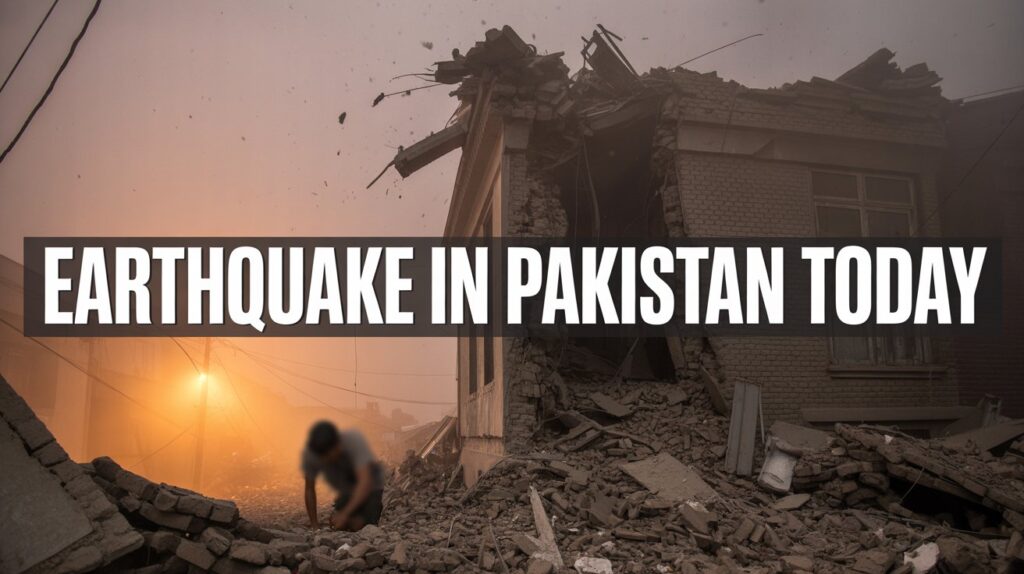Introduction
Pakistan, located at the convergence of the Indian and Eurasian tectonic plates, is one of the most seismically active countries in the world. Earthquakes are a regular occurrence, ranging from minor tremors to devastating events that can cause significant loss of life and property damage. While there has been no major earthquake in Pakistan today (May 10, 2025), the country continues to experience frequent seismic activity. Just yesterday, on May 9, 2025, a 3.7 magnitude earthquake struck 50 km southeast of Khuzdar in Balochistan, serving as a reminder of the constant threat posed by seismic activity in the region. In this article, we explore the recent seismic activity in Pakistan, its geological context, and its implications for the region, including neighboring India.
Recent Earthquakes in Pakistan
According to the National Seismic Monitoring Centre, Pakistan, the earthquake on May 9, 2025, was relatively minor, with a magnitude of 3.7 and a depth of 20 km. Such earthquakes are often felt but typically cause little to no damage. However, the frequency of these events underscores the need for constant vigilance and preparedness.
In 2024, Pakistan experienced approximately 167 earthquakes with magnitudes of 1.5 or greater, highlighting the country’s high seismic activity. Notable earthquakes in 2024 included a 5.7 magnitude quake in September that affected Islamabad and parts of Punjab and Khyber Pakhtunkhwa, and a 5.2 magnitude tremor in November that impacted Peshawar and surrounding areas. These events, while not as catastrophic as larger earthquakes, still cause concern among residents and highlight the need for robust disaster management systems.
Tectonic Setting of Pakistan
Pakistan’s seismic activity is primarily due to its position at the boundary of the Indian and Eurasian plates. The Indian plate is pushing northward into the Eurasian plate at a rate of about 5 cm per year, creating continuous stress and strain along various fault lines. Major fault systems in Pakistan include:
- Chaman Fault: A strike-slip fault running along the western edge of the country.
- Makran Subduction Zone: Located along the southern coast, where the Arabian plate subducts beneath the Eurasian plate.
- Main Mantle Thrust: Part of the Himalayan thrust system, responsible for significant seismic activity in northern Pakistan.
These fault systems are capable of generating earthquakes ranging from moderate to very large magnitudes. The collision of these tectonic plates not only causes frequent earthquakes but also contributes to the formation of the Himalayas, one of the world’s most seismically active mountain ranges.
Impact on the Region
Earthquakes in Pakistan not only affect the country itself but can also be felt in neighboring regions, including India. Northern India, particularly states like Jammu and Kashmir, Punjab, and Delhi, often experience tremors from earthquakes originating in Pakistan or Afghanistan. For example, the 2005 Kashmir earthquake, with a magnitude of 7.6, caused widespread devastation in both Pakistan and India, killing over 87,000 people and injuring many more. The epicenter was near Muzaffarabad in Pakistan-administered Kashmir, but its effects were felt across the border in India as well.
More recently, smaller tremors from Pakistan have been felt in Delhi and surrounding areas. For instance, a 5.7 magnitude earthquake in September 2024 was felt in parts of northern India, causing brief panic but no significant damage. This highlights the interconnectedness of seismic activity across borders and the need for regional cooperation in disaster preparedness.
Historical Significant Earthquakes
Pakistan has a history of devastating earthquakes that have shaped its approach to disaster management. Some of the most significant include:
| Date | Location | Magnitude | Deaths | Notes |
|---|---|---|---|---|
| 2005-10-08 | Azad Kashmir, Balakot | 7.6 | 86,000–87,351 | Extreme damage, deadliest in South Asia, epicenter on Jhelum Fault Zone. |
| 1935-05-31 | Ali Jaan, Balochistan | 7.7 | 30,000–60,000 | Quetta almost completely destroyed. |
| 2015-10-26 | Badakhshan, Afghanistan | 7.5 | 399 | Significant damage in Khyber Pakhtunkhwa and Gilgit-Baltistan. |
These events have underscored the need for robust earthquake preparedness and mitigation strategies in both Pakistan and India.
Preparedness and Mitigation Efforts
Given the high risk of earthquakes, both Pakistan and India have implemented various measures to improve preparedness and reduce the impact of seismic events.
- Pakistan: The National Disaster Management Authority (NDMA) works to enhance disaster response capabilities. Efforts include public awareness campaigns, training for emergency responders, and the development of early warning systems. Building codes are also being updated to ensure structures can withstand seismic activity.
- India: The National Disaster Management Authority, India coordinates earthquake preparedness efforts, including retrofitting critical infrastructure and developing early warning systems. States like Jammu and Kashmir, Uttarakhand, and Himachal Pradesh, which are at high seismic risk, have specific disaster management plans in place.
Both countries also participate in regional initiatives to share data and coordinate responses to cross-border seismic events.
Staying Safe During Earthquakes: Tips for Indian Residents
For our readers in India, especially in northern states like Jammu and Kashmir, Punjab, and Delhi, it’s important to know how to stay safe during earthquakes. Here are some key tips:
- If you’re indoors: Drop to the ground, take cover under a sturdy piece of furniture, and hold on until the shaking stops. Stay away from windows, glass doors, and heavy objects that could fall.
- If you’re outdoors: Move to an open area away from buildings, trees, and power lines. Avoid areas where objects might fall.
- If you’re in a vehicle: Stop the car and stay inside until the shaking stops. Avoid stopping near buildings or under bridges.
- After the earthquake: Check for injuries and provide first aid if needed. Be prepared for aftershocks and follow instructions from local authorities.
It’s also crucial to have a family emergency plan and to know the safe spots in your home or workplace. In India, where phrases like “Dilli ka telur” (Delhi’s earthquake) are sometimes used humorously, it’s important to remember that earthquakes are a serious matter requiring preparation.
Conclusion
While there has been no significant earthquake in Pakistan today, the country’s geological setting ensures that seismic activity will continue. The recent minor earthquake on May 9, 2025, serves as a timely reminder of the need for ongoing vigilance and preparedness. Both Pakistan and India must continue to invest in measures to mitigate the impact of future earthquakes, ensuring the safety of their citizens. For residents in earthquake-prone areas, staying informed and prepared is key to minimizing risks and ensuring a swift recovery when disasters strike.



